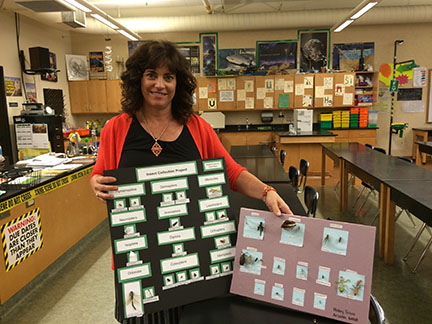Insect project: Bringing knowledge or causing harm?
Some students think killing insects is unnecessary; educators feel that students learn best with ‘hands on’ experiences

Photo credit: Finn Thomas
Science teacher Barbie Miller holding two of her students’ insect collection projects. “Kids are learning in a hands on way how biologists classify things.”
September 25, 2014
By Finn Thomas
Messenger Staff Writer
For their Insect Collection and Identification projects, students have been wandering around Placer High School campus with nets trying to catch and kill insects of all types. However, some of these students are concerned about the insect deaths.
In all the freshman biology classes students collect and kills insects, with acetone, a strong chemical, to then classify in the correct orders. Orders are part of the way scientists classify insects, for example, butterflies and moths are in the order Lepidoptera. Insects can be classified all the way down to their Genus species, which is a two word name for an organism. Students had to collect twenty insects and sort them in the correct orders, along with putting the common name for the bugs.
“Kids are learning in a hands on way how biologists classify living things” Barbie Miller, Placer High School Biology teacher said when asked about what information the students were learning while doing the project.
Although learning plenty about the classification of insects, some students felt like they could have learned about the topic without killing the insects.
“I don’t mind, but I feel like if we are going to observe the insect, we should observe it alive and not dead.” Placer High School Freshman Sydney Buchanan stated, when asked if she felt like killing the insects was okay.
However, some students have a different perspective on the issue.
“I don’t know, because the insects are really small, so you could watch them until they escape,” Samantha Voss, Placer High School Freshman stated, concluding that it would be very hard to observe the insects if they were alive and moving.
Some students were concerned about the amount of insects that were killed within the whole school’s projects. However Miller stated otherwise,
“The number of insects that are sacrificed for the insect project is insignificant when compared to the total population of insects. This is why schools across the nation use the insect project to learn about how living things are classified. It is nearly impossible to classify many insects without being able to look at them closely, using a magnifying lens in most cases. If we were to try to examine live insects, they would suffer from the handling and likely damage that would be caused.”
Alongside this, the science department made sure no students killed honeybees. Honeybees are suffering from Colony Collapse Disorder, which means that they’re population is increasing in deaths. This is happening for multiple reasons, one being pesticides getting into their systems, which leads to eventual death. Students didn’t kill the honeybees, because of the threat of them being possibly endangered someday.
Several students may feel that there could be a better way to learn about this topic, however, although empathic about the insects, Miller confirmed,
“There is no other comparable way to learn about the classification of living things. We can, of course, learn information about insects by reading a book, hearing a lecture, or watching a video. There may even be a video that describes how insects are classified, but that video would be very boring and likely at a college level. Actually catching and examining real insects is a hands-on way that students can learn by doing.”
Additionally, because of the hands on way of learning many students actually enjoy the project, and learn how to classify insects successfully. However, a few students are reluctant to kill the insects and finish the project.
“By far, students seem to enjoy this project. They like to go outside and hunt, pin and even key out the insects. There is a small minority of students that would rather not do the project. I am very empathetic to their feelings about sacrificing insects. I sometimes have a hard time with it myself,” Miller said.
Although each student has a different opinion involving the Insect Collection and Identification Project, the information learned hands on about how biologist classify insects is important to the biology curriculum.


Tommy • Sep 23, 2021 at 11:58 am
So what happens to the students who don’t want to do this project (which I very much empathize with, as someone who is scared of bugs and also doesn’t want to give them painful deaths in nail polish removal)? do they get other projects they can do as a substitute?